Abstract
Polychlorinated biphenyls (PCBs) are ubiquitous global contaminants that have been intensively investigated for three decades. They are broad-acting toxicants occurring in complex mixtures and accurate risk assessment has proven to be elusive. Focusing on a limited set of end points and emphasizing a fixed set of congeners have led to more streamlined data sets that are meant to expedite hazard characterization and risk assessment for the most potent congeners--aryl hydrocarbon receptor (AhR) agonists. Unfortunately, this has made it impossible to confirm or deny significant contributions from the more prevalent components of the mixtures. PCBs may be only coincidentally present, rather than causal, in some diseases. Still, attempts to determine associations with incomplete residue data may lead to erroneous conclusions and make accurate risk assessment even more elusive. Responses not mediated through the AhR are presented and emphasize large data gaps. Dissimilar analytical reports emphasize that selection of analytes is not consistent. Collectively, these data confirm that AhR-focused objectives unintentionally created the impression that nonplanar PCBs have little if any potential for hazards to humans and wildlife. Near steady-state exposure of healthy adults are probably of minor consequence except for emerging correlations with non-Hodgkin's lymphoma; however, pulses of exposure to more labile mixtures may contribute to developmental effects without leaving a residue record. More broadly based criteria are suggested and harmonization of data collection and presentation are desirable. A more comprehensive list of PCB congeners is proposed that would provide more adequate data upon which to base associations with adverse outcomes.
Full text
PDF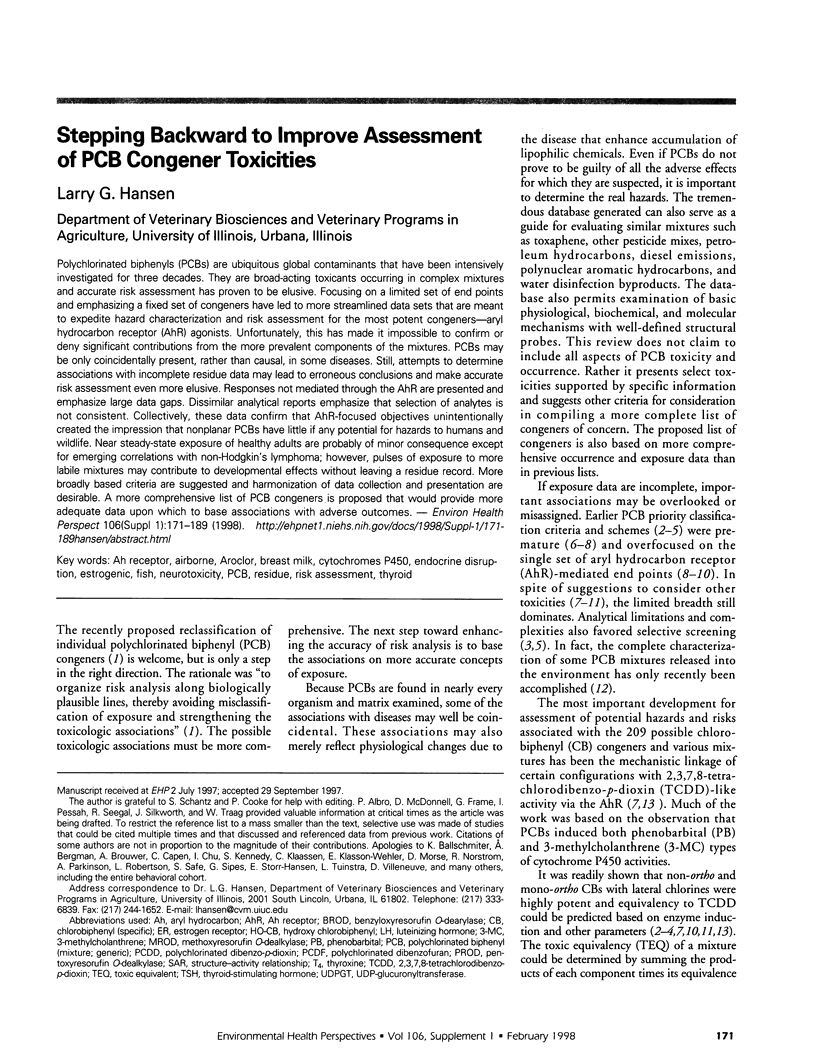
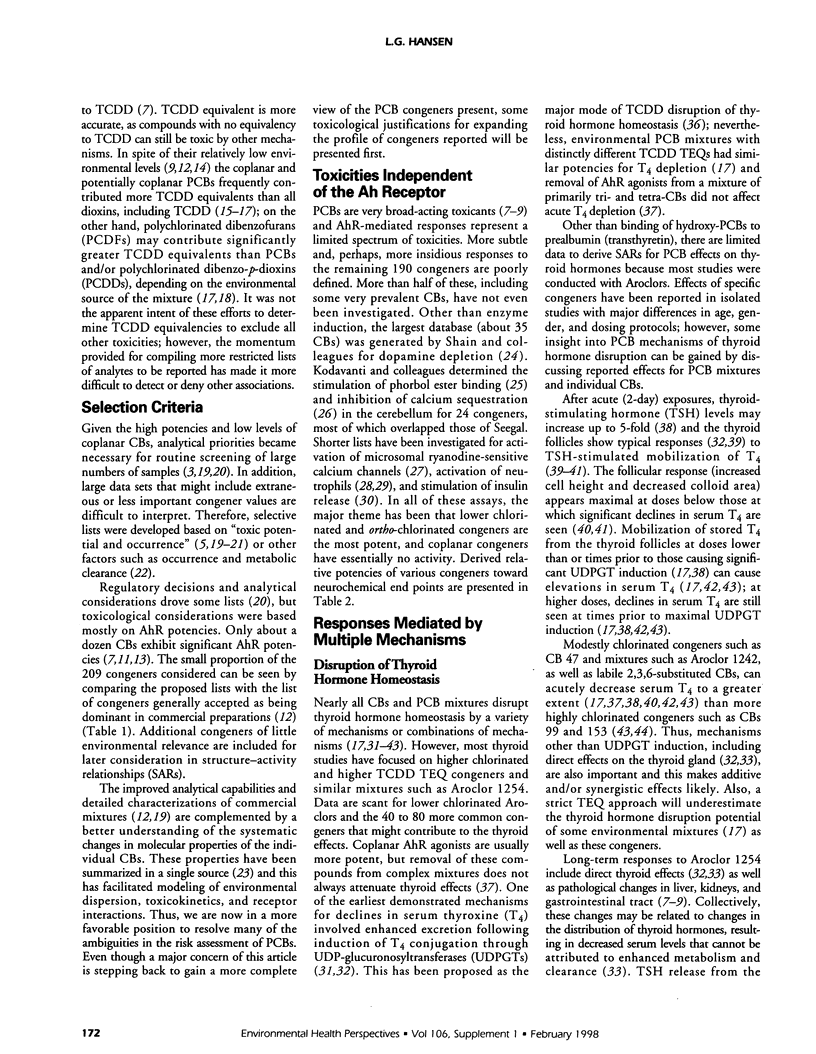
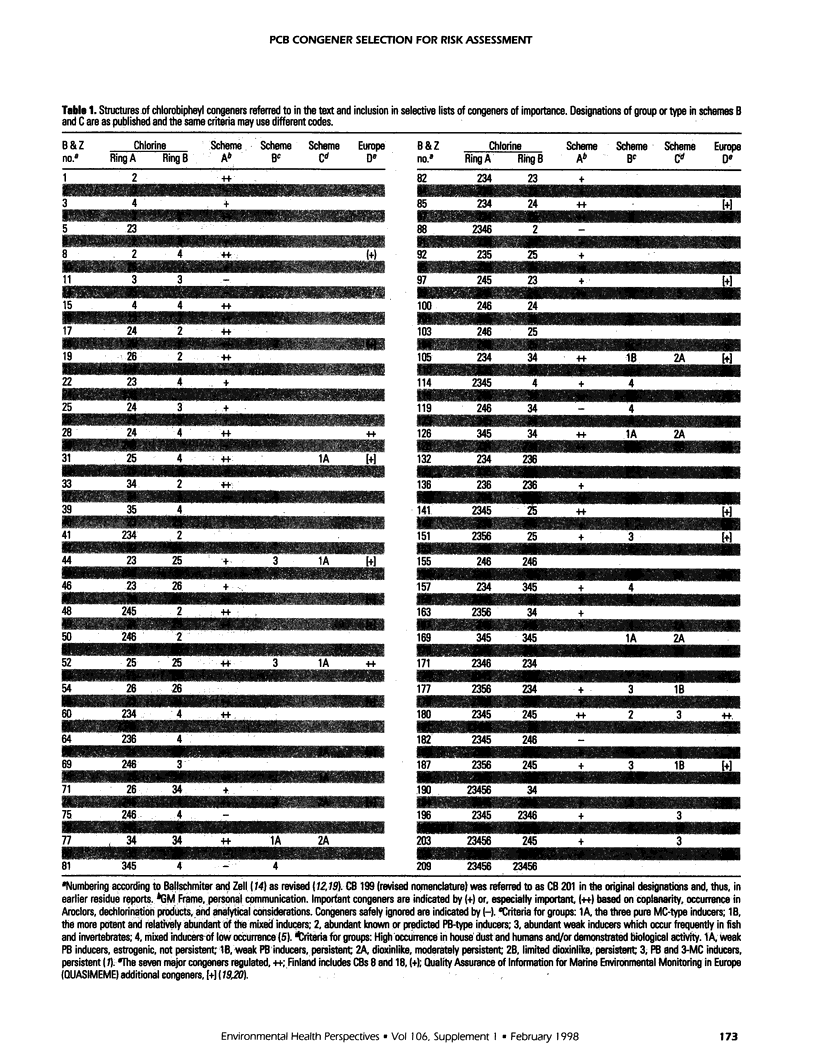
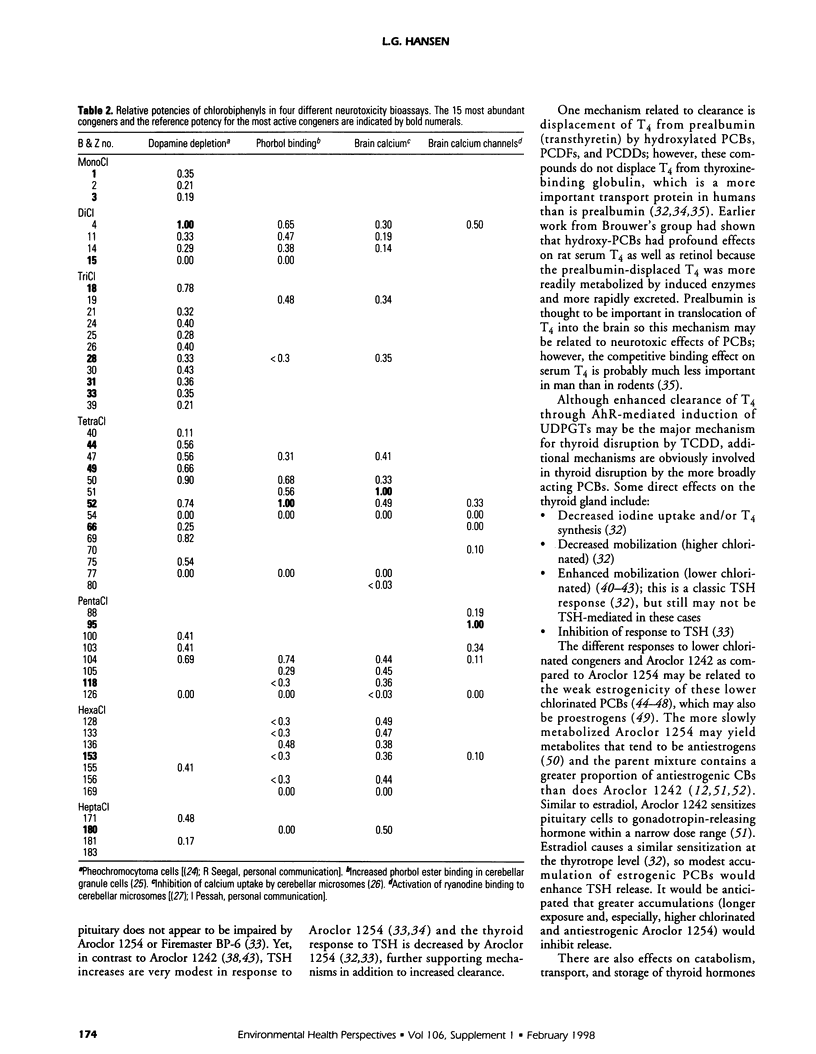
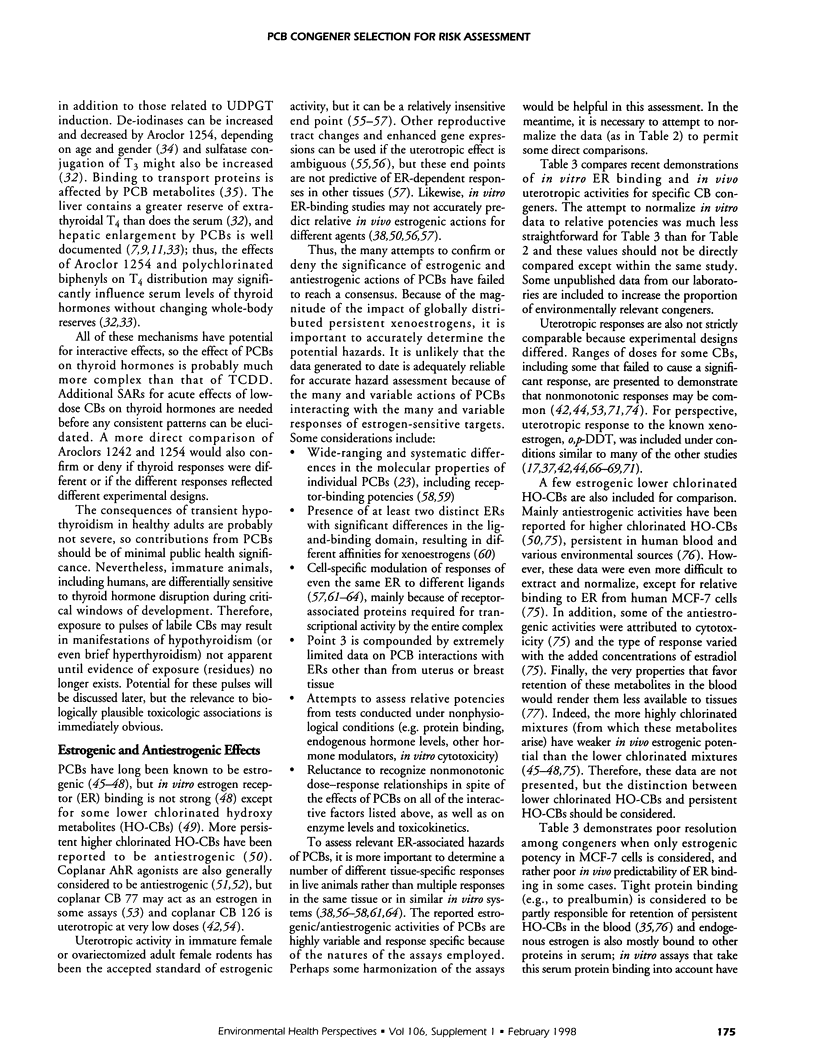
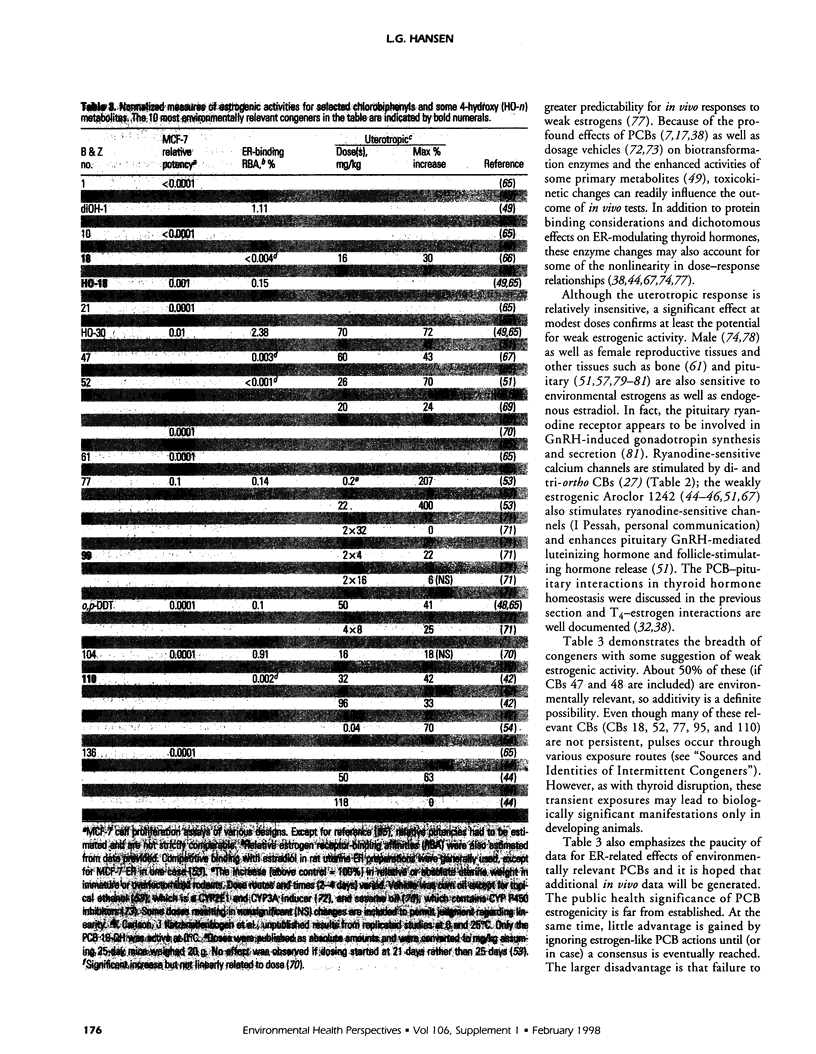
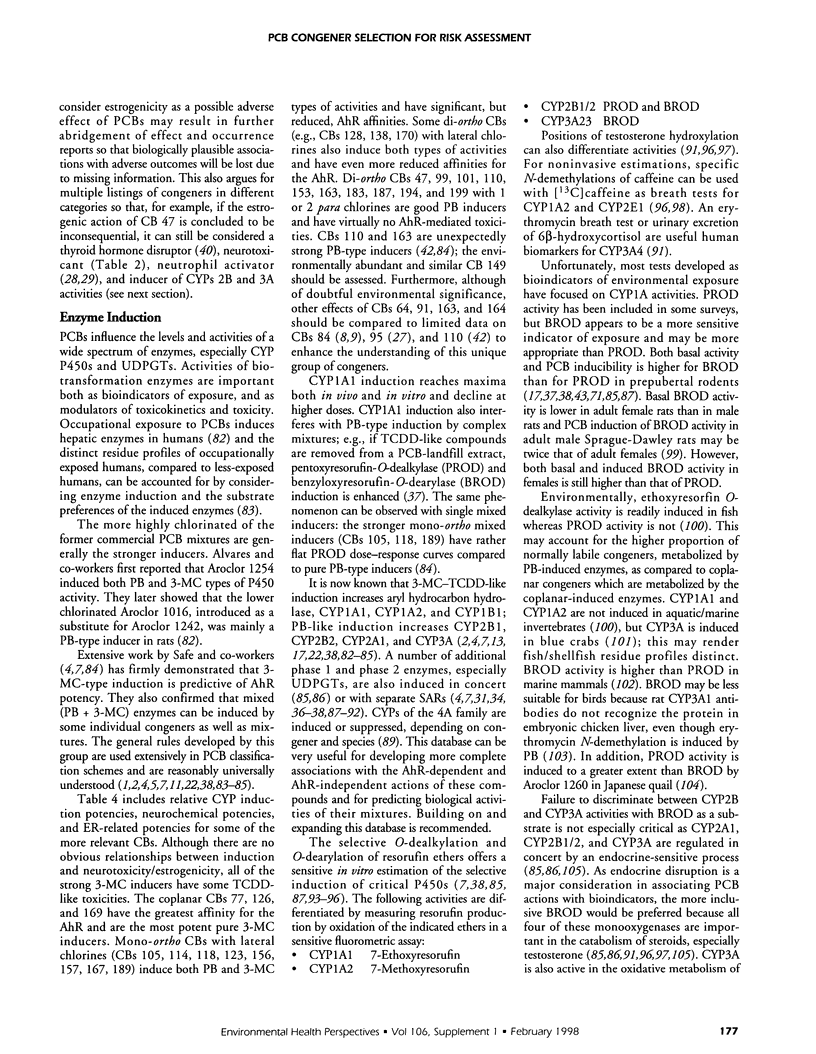
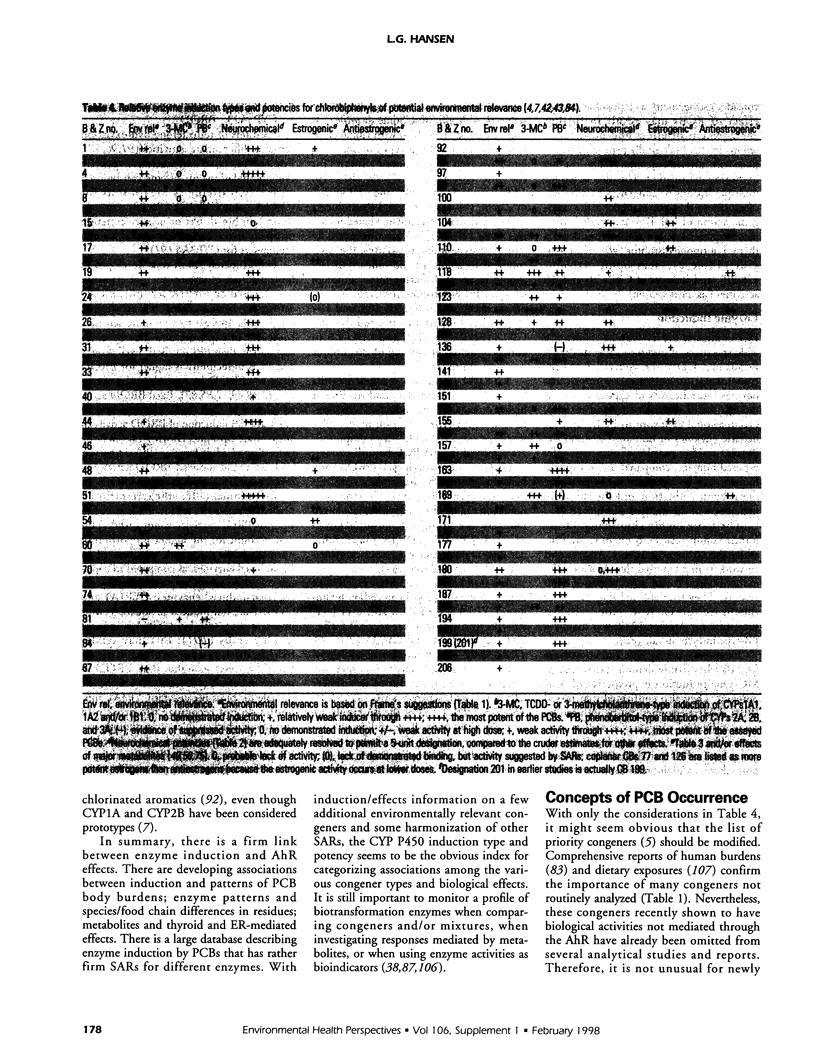
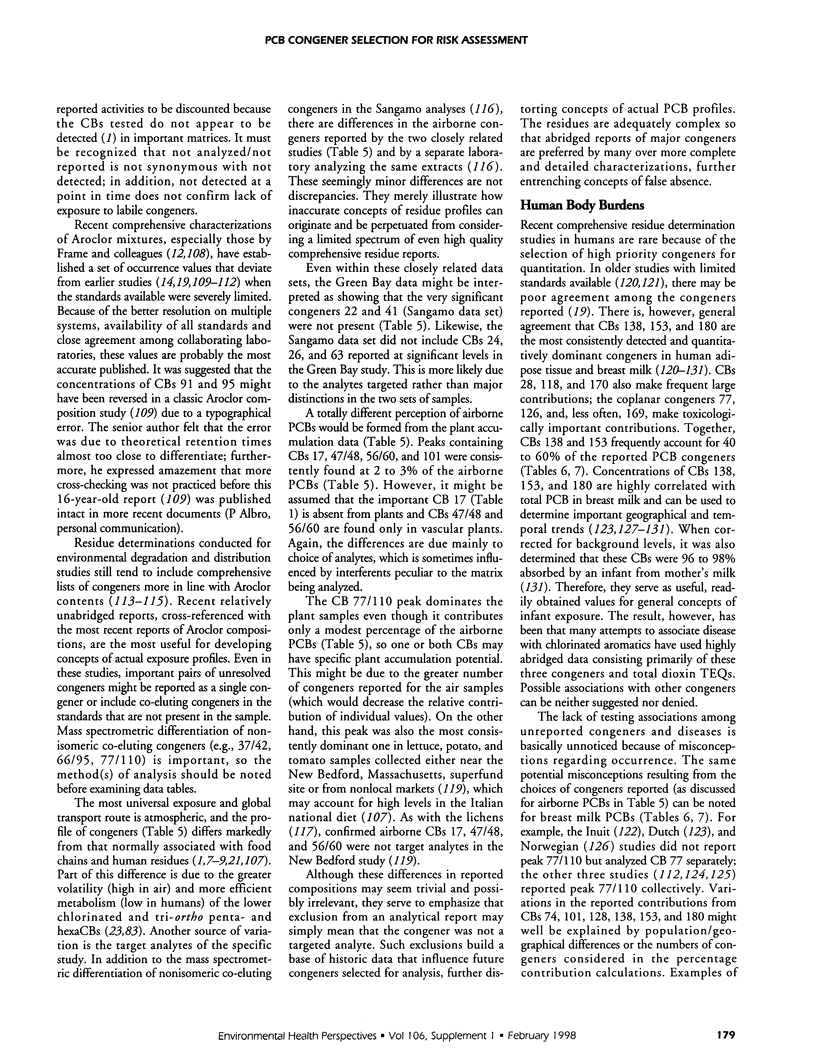
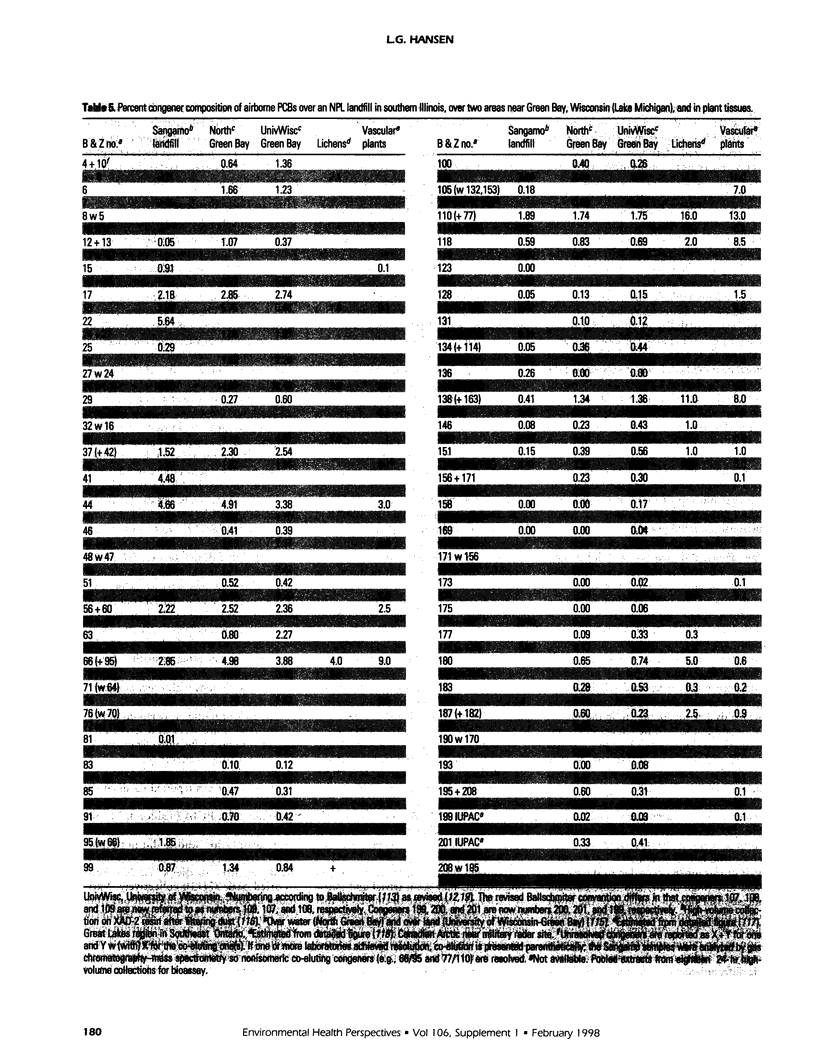
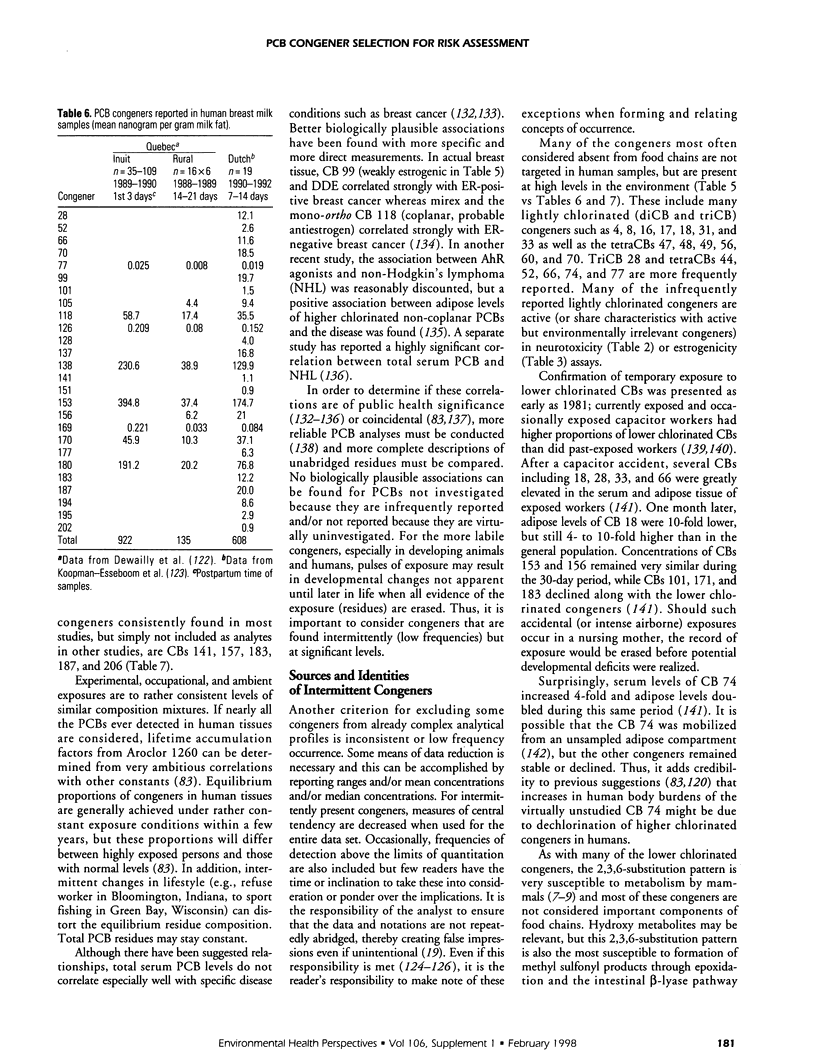
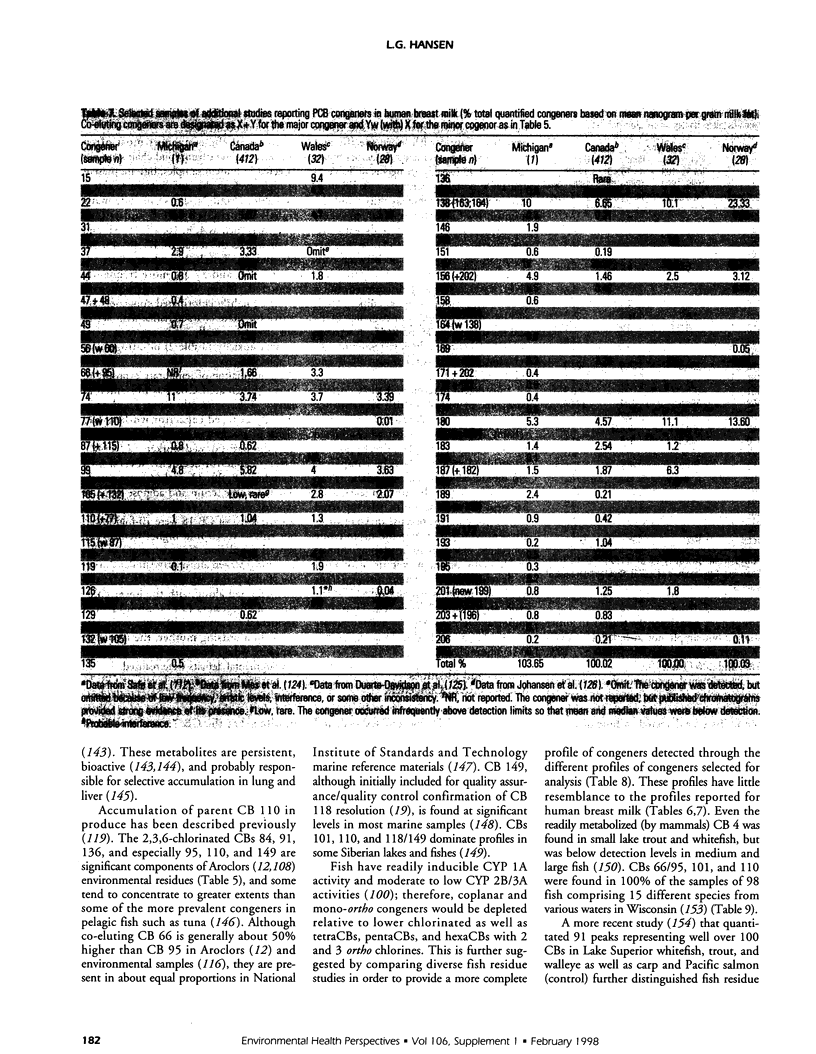
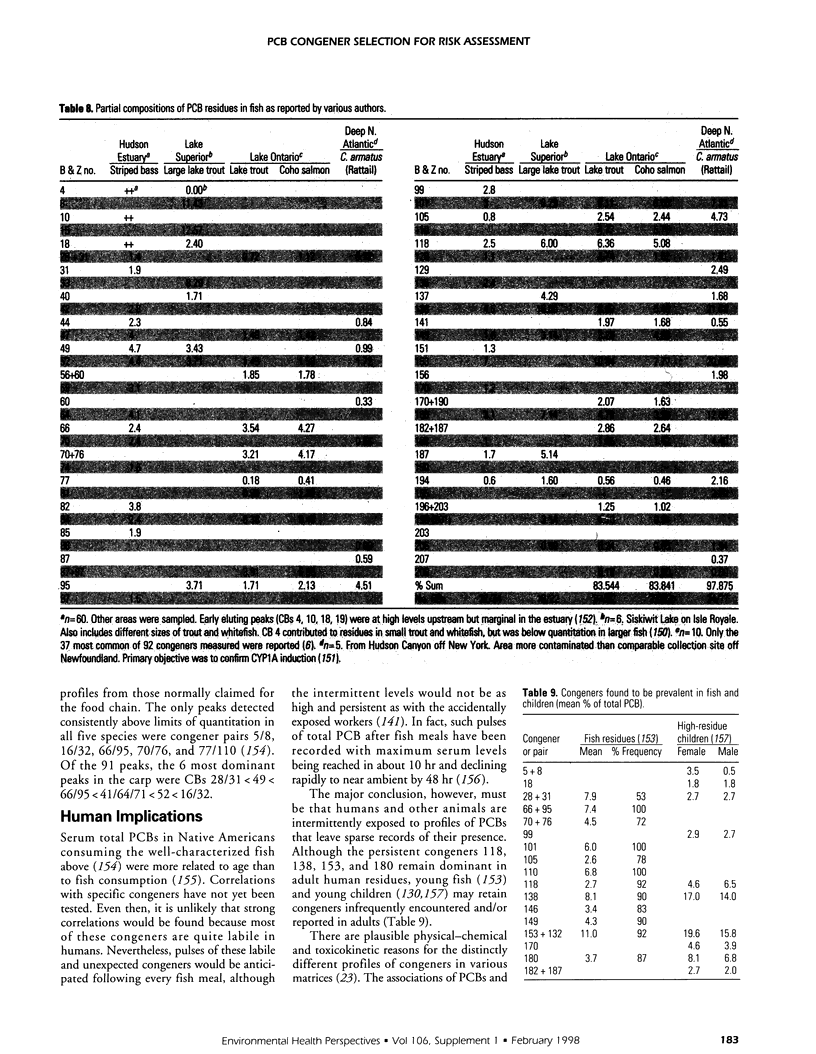
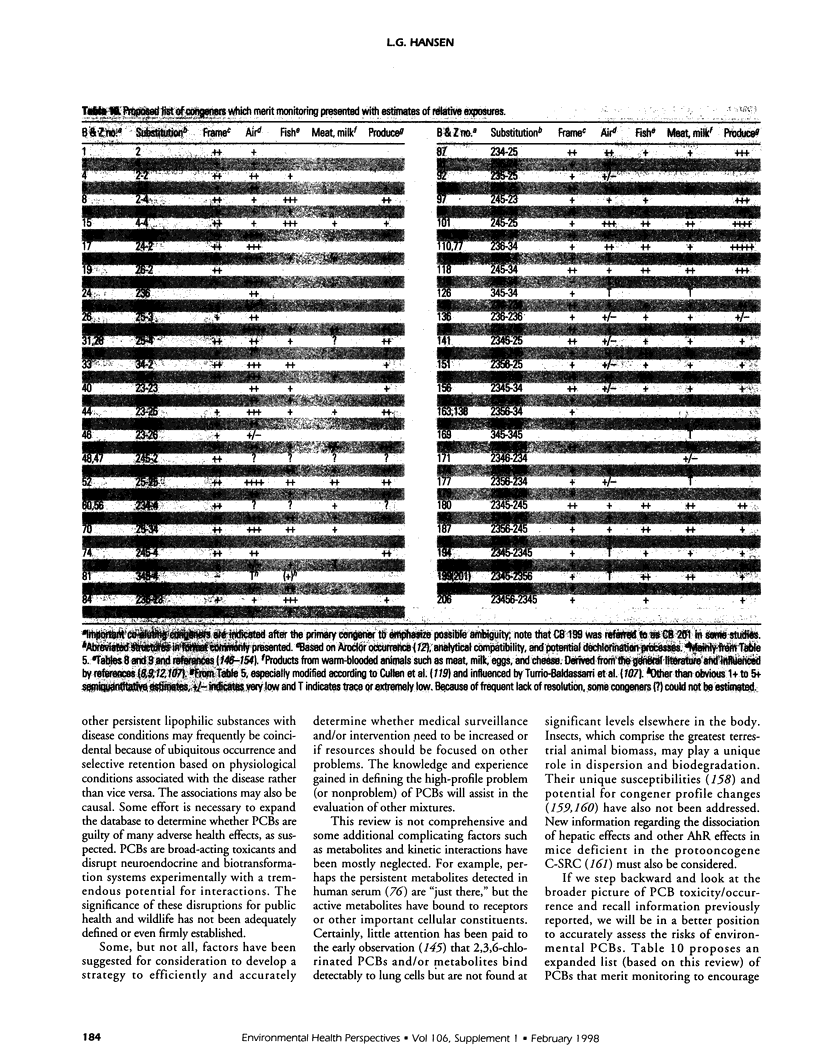
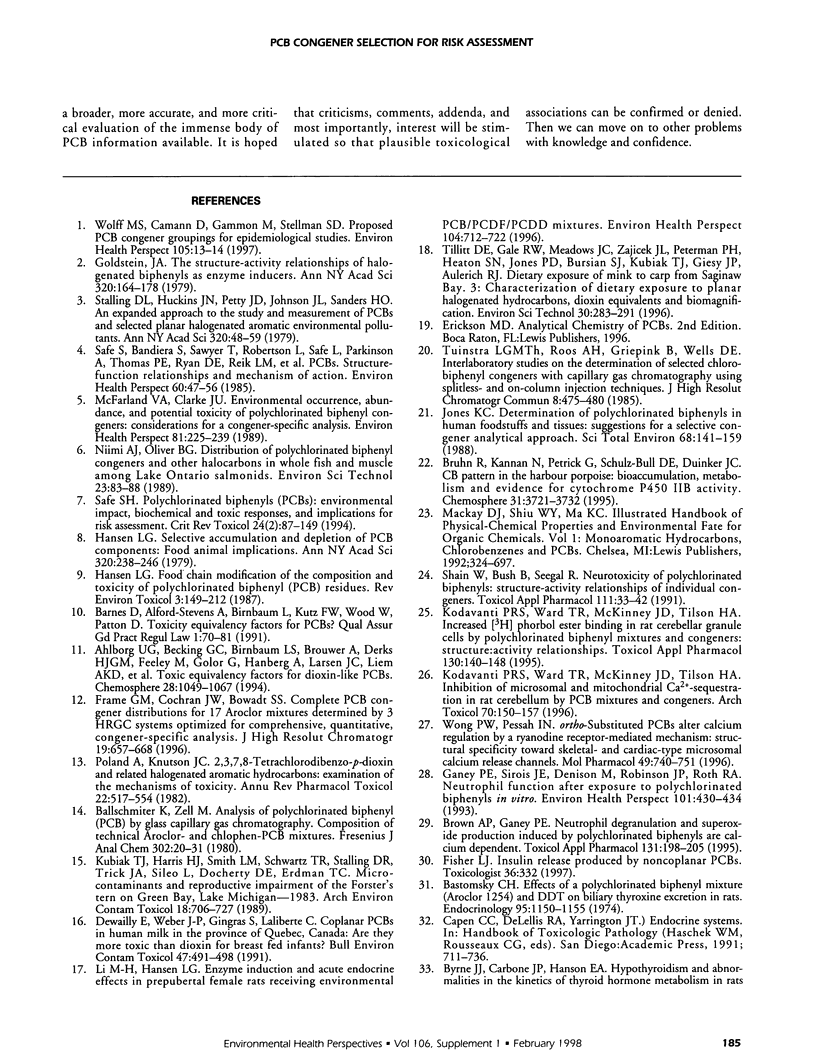
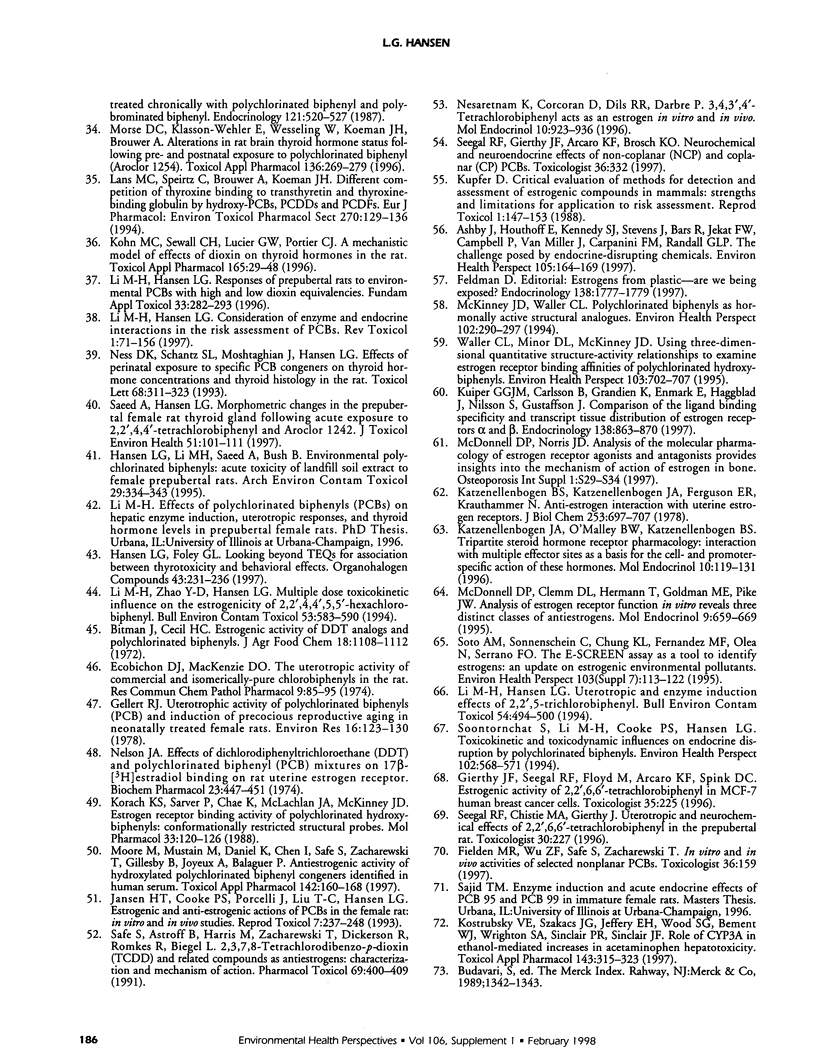
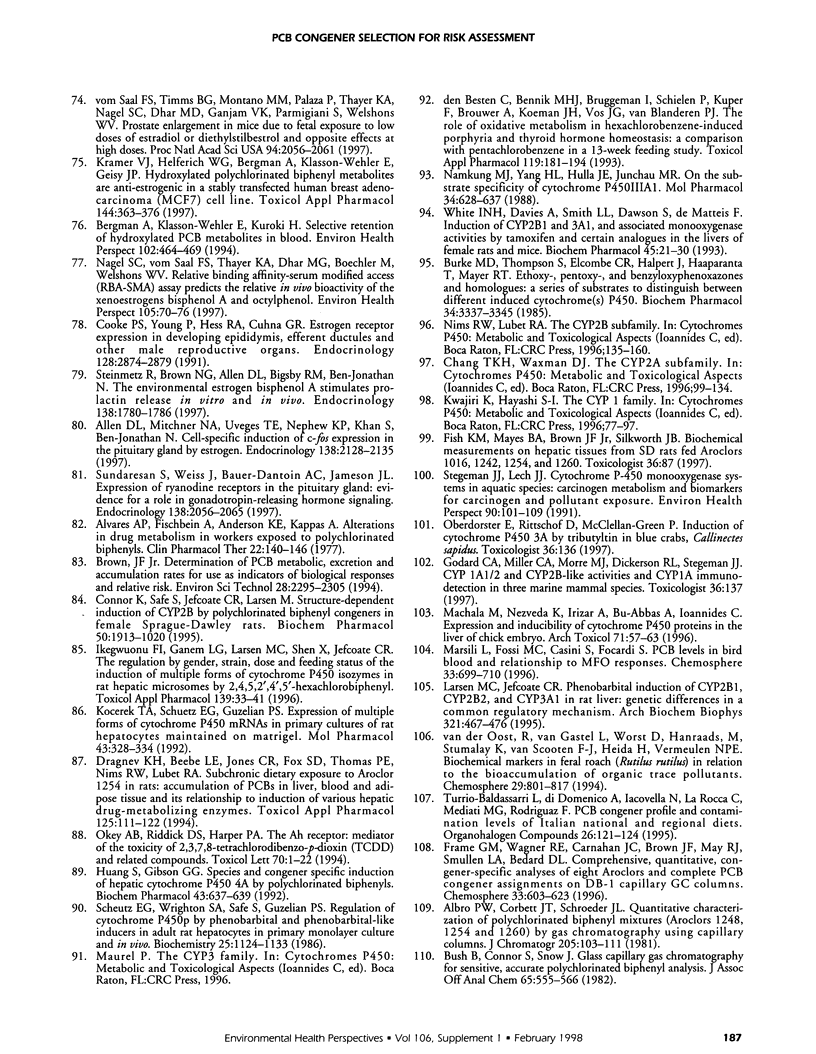
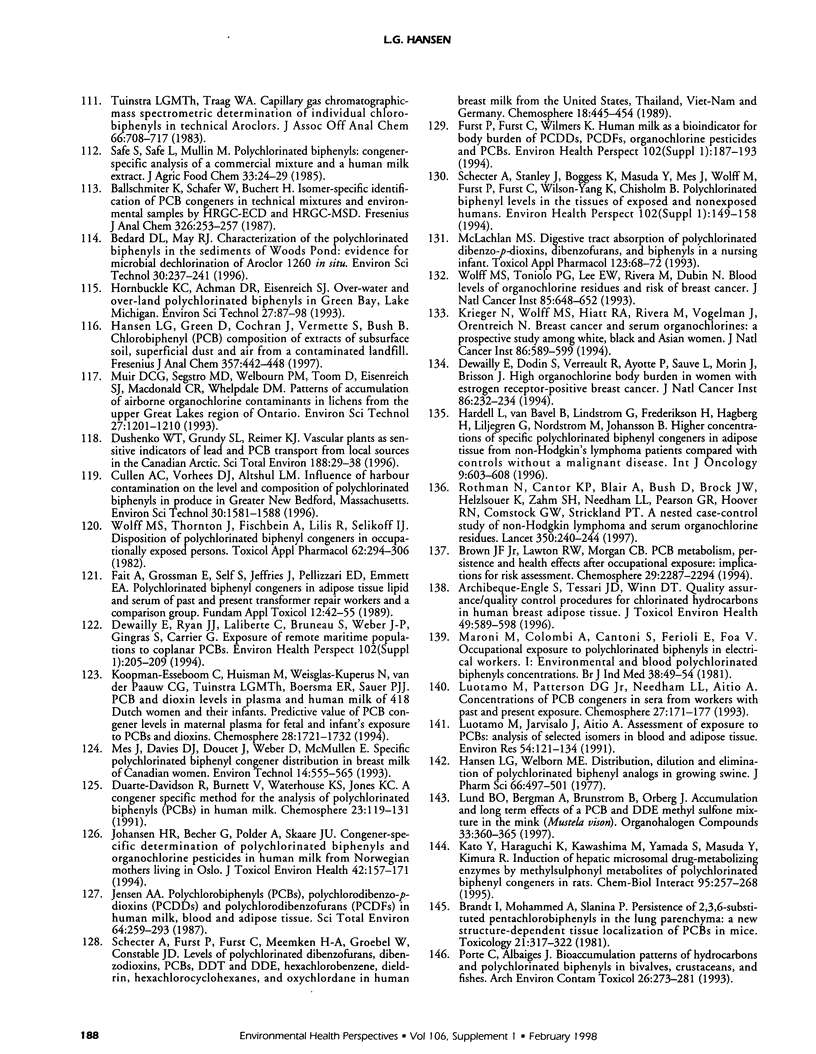
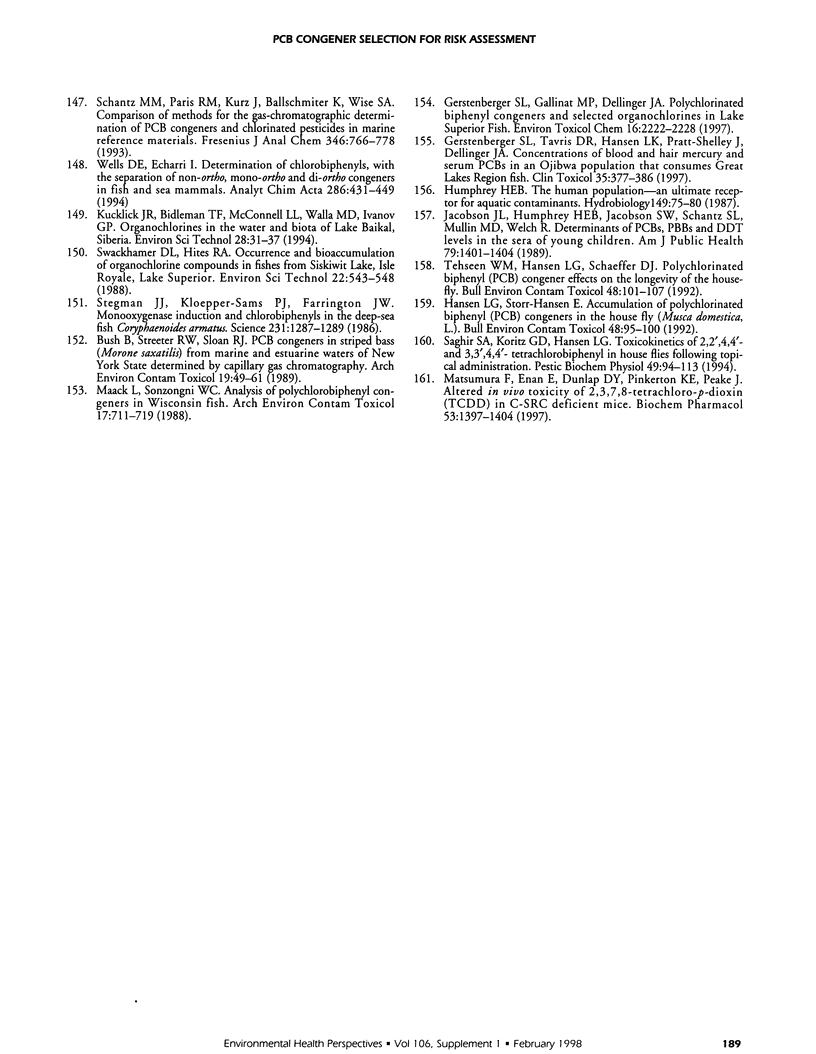
Selected References
These references are in PubMed. This may not be the complete list of references from this article.
- Allen D. L., Mitchner N. A., Uveges T. E., Nephew K. P., Khan S., Ben-Jonathan N. Cell-specific induction of c-fos expression in the pituitary gland by estrogen. Endocrinology. 1997 May;138(5):2128–2135. doi: 10.1210/endo.138.5.5101. [DOI] [PubMed] [Google Scholar]
- Alvares A. P., Fischbein A., Anderson K. E., Kappas A. Alterations in drug metabolism in workers exposed to polychlorinated biphenyls. Clin Pharmacol Ther. 1977 Aug;22(2):140–146. doi: 10.1002/cpt1977222140. [DOI] [PubMed] [Google Scholar]
- Archibeque-Engle S., Tessari J. D., Winn D. T. Quality assurance/quality control procedures for chlorinated hydrocarbons in human breast adipose tissue. J Toxicol Environ Health. 1996 Dec 27;49(6):589–598. doi: 10.1080/009841096160646. [DOI] [PubMed] [Google Scholar]
- Ashby J., Houthoff E., Kennedy S. J., Stevens J., Bars R., Jekat F. W., Campbell P., Van Miller J., Carpanini F. M., Randall G. L. The challenge posed by endocrine-disrupting chemicals. Environ Health Perspect. 1997 Feb;105(2):164–169. doi: 10.1289/ehp.97105164. [DOI] [PMC free article] [PubMed] [Google Scholar]
- Barnes D., Alford-Stevens A., Birnbaum L., Kutz F. W., Wood W., Patton D. Toxicity equivalency factors for PCBs? Qual Assur. 1991 Oct;1(1):70–81. [PubMed] [Google Scholar]
- Bastomsky C. H. Effects of a polychlorinated biphenyl mixture (aroclor 1254) and DDT on biliary thyroxine excretion in rats. Endocrinology. 1974 Oct;95(4):1150–1155. doi: 10.1210/endo-95-4-1150. [DOI] [PubMed] [Google Scholar]
- Bergman A., Klasson-Wehler E., Kuroki H. Selective retention of hydroxylated PCB metabolites in blood. Environ Health Perspect. 1994 May;102(5):464–469. doi: 10.1289/ehp.94102464. [DOI] [PMC free article] [PubMed] [Google Scholar]
- Bitman J., Cecil H. C. Estrogenic activity of DDT analogs and polychlorinated biphenyls. J Agric Food Chem. 1970 Nov-Dec;18(6):1108–1112. doi: 10.1021/jf60172a019. [DOI] [PubMed] [Google Scholar]
- Brandt I., Mohammed A., Slanina P. Persistence of 2,3,6-substituted pentachlorobiphenyls in the lung parenchyma: a new structure-dependent tissue localization of polychlorinated biphenyls in mice. Toxicology. 1981;21(4):317–322. doi: 10.1016/0300-483x(81)90146-3. [DOI] [PubMed] [Google Scholar]
- Brown A. P., Ganey P. E. Neutrophil degranulation and superoxide production induced by polychlorinated biphenyls are calcium dependent. Toxicol Appl Pharmacol. 1995 Apr;131(2):198–205. doi: 10.1006/taap.1995.1062. [DOI] [PubMed] [Google Scholar]
- Brown J. F., Jr, Lawton R. W., Morgan C. B. PCB metabolism, persistence, and health effects after occupational exposure: implications for risk assessment. Chemosphere. 1994 Nov-Dec;29(9-11):2287–2294. doi: 10.1016/0045-6535(94)90396-4. [DOI] [PubMed] [Google Scholar]
- Bruhn R., Kannan N., Petrick G., Schulz-Bull D. E., Duinker J. C. CB pattern in the harbour porpoise: bioaccumulation, metabolism and evidence for cytochrome P450 IIB activity. Chemosphere. 1995 Oct;31(7):3721–3732. doi: 10.1016/0045-6535(95)00221-s. [DOI] [PubMed] [Google Scholar]
- Burke M. D., Thompson S., Elcombe C. R., Halpert J., Haaparanta T., Mayer R. T. Ethoxy-, pentoxy- and benzyloxyphenoxazones and homologues: a series of substrates to distinguish between different induced cytochromes P-450. Biochem Pharmacol. 1985 Sep 15;34(18):3337–3345. doi: 10.1016/0006-2952(85)90355-7. [DOI] [PubMed] [Google Scholar]
- Bush B., Streeter R. W., Sloan R. J. Polychlorobiphenyl (PCB) congeners in striped bass (Morone saxatilis) from marine and estuarine waters of New York State determined by capillary gas chromatography. Arch Environ Contam Toxicol. 1990 Jan-Feb;19(1):49–61. doi: 10.1007/BF01059812. [DOI] [PubMed] [Google Scholar]
- Connor K., Safe S., Jefcoate C. R., Larsen M. Structure-dependent induction of CYP2B by polychlorinated biphenyl congeners in female Sprague-Dawley rats. Biochem Pharmacol. 1995 Nov 27;50(11):1913–1920. doi: 10.1016/0006-2952(95)02087-x. [DOI] [PubMed] [Google Scholar]
- Cooke P. S., Young P., Hess R. A., Cunha G. R. Estrogen receptor expression in developing epididymis, efferent ductules, and other male reproductive organs. Endocrinology. 1991 Jun;128(6):2874–2879. doi: 10.1210/endo-128-6-2874. [DOI] [PubMed] [Google Scholar]
- Dewailly E., Dodin S., Verreault R., Ayotte P., Sauvé L., Morin J., Brisson J. High organochlorine body burden in women with estrogen receptor-positive breast cancer. J Natl Cancer Inst. 1994 Feb 2;86(3):232–234. doi: 10.1093/jnci/86.3.232. [DOI] [PubMed] [Google Scholar]
- Dewailly E., Ryan J. J., Laliberté C., Bruneau S., Weber J. P., Gingras S., Carrier G. Exposure of remote maritime populations to coplanar PCBs. Environ Health Perspect. 1994 Jan;102 (Suppl 1):205–209. doi: 10.1289/ehp.94102s1205. [DOI] [PMC free article] [PubMed] [Google Scholar]
- Dewailly E., Weber J. P., Gingras S., Laliberté C. Coplanar PCBs in human milk in the province of Québec, Canada: are they more toxic than dioxin for breast fed infants? Bull Environ Contam Toxicol. 1991 Oct;47(4):491–498. doi: 10.1007/BF01700935. [DOI] [PubMed] [Google Scholar]
- Dragnev K. H., Beebe L. E., Jones C. R., Fox S. D., Thomas P. E., Nims R. W., Lubet R. A. Subchronic dietary exposure to Aroclor 1254 in rats: accumulation of PCBs in liver, blood, and adipose tissue and its relationship to induction of various hepatic drug-metabolizing enzymes. Toxicol Appl Pharmacol. 1994 Mar;125(1):111–122. doi: 10.1006/taap.1994.1055. [DOI] [PubMed] [Google Scholar]
- Dushenko W. T., Grundy S. L., Reimer K. J. Vascular plants as sensitive indicators of lead and PCB transport from local sources in the Canadian Arctic. Sci Total Environ. 1996 Sep 20;188(1):29–38. doi: 10.1016/0048-9697(96)05154-6. [DOI] [PubMed] [Google Scholar]
- Ecobichon D. J., MacKenzie D. O. The uterotropic activity of commercial and isomerically-pure chlorobiphenyls in the rat. Res Commun Chem Pathol Pharmacol. 1974 Sep;9(1):85–95. [PubMed] [Google Scholar]
- Fait A., Grossman E., Self S., Jeffries J., Pellizzari E. D., Emmett E. A. Polychlorinated biphenyl congeners in adipose tissue lipid and serum of past and present transformer repair workers and a comparison group. Fundam Appl Toxicol. 1989 Jan;12(1):42–55. doi: 10.1016/0272-0590(89)90060-2. [DOI] [PubMed] [Google Scholar]
- Feldman D. Estrogens from plastic--are we being exposed? Endocrinology. 1997 May;138(5):1777–1779. doi: 10.1210/endo.138.5.5213. [DOI] [PubMed] [Google Scholar]
- Fürst P., Fürst C., Wilmers K. Human milk as a bioindicator for body burden of PCDDs, PCDFs, organochlorine pesticides, and PCBs. Environ Health Perspect. 1994 Jan;102 (Suppl 1):187–193. doi: 10.1289/ehp.102-1566908. [DOI] [PMC free article] [PubMed] [Google Scholar]
- Ganey P. E., Sirois J. E., Denison M., Robinson J. P., Roth R. A. Neutrophil function after exposure to polychlorinated biphenyls in vitro. Environ Health Perspect. 1993 Oct;101(5):430–434. doi: 10.1289/ehp.93101430. [DOI] [PMC free article] [PubMed] [Google Scholar]
- Gellert R. J. Uterotrophic activity of polychlorinated biphenyls (PCB) and induction of precocious reproductive aging in neonatally treated female rats. Environ Res. 1978 Jul;16(1-3):123–130. doi: 10.1016/0013-9351(78)90149-4. [DOI] [PubMed] [Google Scholar]
- Gerstenberger S. L., Tavris D. R., Hansen L. K., Pratt-Shelley J., Dellinger J. A. Concentrations of blood and hair mercury and serum PCBs in an Ojibwa population that consumes Great Lakes region fish. J Toxicol Clin Toxicol. 1997;35(4):377–386. doi: 10.3109/15563659709043370. [DOI] [PubMed] [Google Scholar]
- Goldstein J. A. The structure-activity relationships of halogenated biphenyls as enzyme inducers. Ann N Y Acad Sci. 1979 May 31;320:164–178. [PubMed] [Google Scholar]
- Hansen L. G., Li M. H., Saeed A., Bush B. Environmental polychlorinated biphenyls: acute toxicity of landfill soil extract to female prepubertal rats. Arch Environ Contam Toxicol. 1995 Oct;29(3):334–343. doi: 10.1007/BF00212498. [DOI] [PubMed] [Google Scholar]
- Hansen L. G. Selective accumulation and depletion of polychlorinated biphenyl components: food animal implications. Ann N Y Acad Sci. 1979 May 31;320:238–246. doi: 10.1111/j.1749-6632.1979.tb56605.x. [DOI] [PubMed] [Google Scholar]
- Hansen L. G., Storr-Hansen E. Accumulation and depletion of polychlorinated biphenyl (PCB) congeners in the housefly (Musca domestica, L.). Bull Environ Contam Toxicol. 1992 Jan;48(1):95–100. doi: 10.1007/BF00197489. [DOI] [PubMed] [Google Scholar]
- Hansen L. G., Welborn M. E. Distribution, dilution and elimination of polychlorinated biphenyl analogs in growing swine. J Pharm Sci. 1977 Apr;66(4):497–501. doi: 10.1002/jps.2600660410. [DOI] [PubMed] [Google Scholar]
- Huang S., Gibson G. G. Species and congener specific induction of hepatic cytochrome P4504A by polychlorinated biphenyls. Biochem Pharmacol. 1992 Feb 4;43(3):637–639. doi: 10.1016/0006-2952(92)90588-a. [DOI] [PubMed] [Google Scholar]
- Ikegwuonu F. I., Ganem L. G., Larson M. C., Shen X., Jefcoate C. R. The regulation by gender, strain, dose, and feeding status of the induction of multiple forms of cytochrome P450 isozymes in rat hepatic microsomes by 2,4,5,2',4',5'-hexachlorobiphenyl. Toxicol Appl Pharmacol. 1996 Jul;139(1):33–41. doi: 10.1006/taap.1996.0140. [DOI] [PubMed] [Google Scholar]
- Jacobson J. L., Humphrey H. E., Jacobson S. W., Schantz S. L., Mullin M. D., Welch R. Determinants of polychlorinated biphenyls (PCBs), polybrominated biphenyls (PBBs), and dichlorodiphenyl trichloroethane (DDT) levels in the sera of young children. Am J Public Health. 1989 Oct;79(10):1401–1404. doi: 10.2105/ajph.79.10.1401. [DOI] [PMC free article] [PubMed] [Google Scholar]
- Jansen H. T., Cooke P. S., Porcelli J., Liu T. C., Hansen L. G. Estrogenic and antiestrogenic actions of PCBs in the female rat: in vitro and in vivo studies. Reprod Toxicol. 1993 May-Jun;7(3):237–248. doi: 10.1016/0890-6238(93)90230-5. [DOI] [PubMed] [Google Scholar]
- Jensen A. A. Polychlorobiphenyls (PCBs), polychlorodibenzo-p-dioxins (PCDDs) and polychlorodibenzofurans (PCDFs) in human milk, blood and adipose tissue. Sci Total Environ. 1987 Jul;64(3):259–293. doi: 10.1016/0048-9697(87)90250-6. [DOI] [PubMed] [Google Scholar]
- Johansen H. R., Becher G., Polder A., Skaare J. U. Congener-specific determination of polychlorinated biphenyls and organochlorine pesticides in human milk from Norwegian mothers living in Oslo. J Toxicol Environ Health. 1994 Jun;42(2):157–171. doi: 10.1080/15287399409531870. [DOI] [PubMed] [Google Scholar]
- Jones K. C. Determination of polychlorinated biphenyls in human foodstuffs and tissues: suggestions for a selective congener analytical approach. Sci Total Environ. 1988 Jan;68:141–159. doi: 10.1016/0048-9697(88)90367-1. [DOI] [PubMed] [Google Scholar]
- Kato Y., Haraguchi K., Kawashima M., Yamada S., Masuda Y., Kimura R. Induction of hepatic microsomal drug-metabolizing enzymes by methylsulphonyl metabolites of polychlorinated biphenyl congeners in rats. Chem Biol Interact. 1995 Apr 14;95(3):257–268. doi: 10.1016/0009-2797(94)03564-o. [DOI] [PubMed] [Google Scholar]
- Katzenellenbogen B. S., Katzenellenbogen J. A., Ferguson E. R., Krauthammer N. Anti-estrogen interaction with uterine estrogen receptors. Studies with a radiolabeled anti-estrogen (CI-628). J Biol Chem. 1978 Feb 10;253(3):697–707. [PubMed] [Google Scholar]
- Katzenellenbogen J. A., O'Malley B. W., Katzenellenbogen B. S. Tripartite steroid hormone receptor pharmacology: interaction with multiple effector sites as a basis for the cell- and promoter-specific action of these hormones. Mol Endocrinol. 1996 Feb;10(2):119–131. doi: 10.1210/mend.10.2.8825552. [DOI] [PubMed] [Google Scholar]
- Kocarek T. A., Schuetz E. G., Guzelian P. S. Expression of multiple forms of cytochrome P450 mRNAs in primary cultures of rat hepatocytes maintained on matrigel. Mol Pharmacol. 1993 Mar;43(3):328–334. [PubMed] [Google Scholar]
- Kodavanti P. R., Ward T. R., McKinney J. D., Tilson H. A. Increased [3H]phorbol ester binding in rat cerebellar granule cells by polychlorinated biphenyl mixtures and congeners: structure-activity relationships. Toxicol Appl Pharmacol. 1995 Jan;130(1):140–148. doi: 10.1006/taap.1995.1018. [DOI] [PubMed] [Google Scholar]
- Kodavanti P. R., Ward T. R., McKinney J. D., Tilson H. A. Inhibition of microsomal and mitochondrial Ca2+-sequestration in rat cerebellum by polychlorinated biphenyl mixtures and congeners. Structure-activity relationships. Arch Toxicol. 1996;70(3-4):150–157. doi: 10.1007/s002040050254. [DOI] [PubMed] [Google Scholar]
- Kohn M. C., Sewall C. H., Lucier G. W., Portier C. J. A mechanistic model of effects of dioxin on thyroid hormones in the rat. Toxicol Appl Pharmacol. 1996 Jan;136(1):29–48. doi: 10.1006/taap.1996.0004. [DOI] [PubMed] [Google Scholar]
- Korach K. S., Sarver P., Chae K., McLachlan J. A., McKinney J. D. Estrogen receptor-binding activity of polychlorinated hydroxybiphenyls: conformationally restricted structural probes. Mol Pharmacol. 1988 Jan;33(1):120–126. [PubMed] [Google Scholar]
- Kostrubsky V. E., Szakacs J. G., Jeffery E. H., Wood S. G., Bement W. J., Wrighton S. A., Sinclair P. R., Sinclair J. F. Role of CYP3A in ethanol-mediated increases in acetaminophen hepatotoxicity. Toxicol Appl Pharmacol. 1997 Apr;143(2):315–323. doi: 10.1006/taap.1996.8081. [DOI] [PubMed] [Google Scholar]
- Kramer V. J., Helferich W. G., Bergman A., Klasson-Wehler E., Giesy J. P. Hydroxylated polychlorinated biphenyl metabolites are anti-estrogenic in a stably transfected human breast adenocarcinoma (MCF7) cell line. Toxicol Appl Pharmacol. 1997 Jun;144(2):363–376. doi: 10.1006/taap.1997.8163. [DOI] [PubMed] [Google Scholar]
- Krieger N., Wolff M. S., Hiatt R. A., Rivera M., Vogelman J., Orentreich N. Breast cancer and serum organochlorines: a prospective study among white, black, and Asian women. J Natl Cancer Inst. 1994 Apr 20;86(8):589–599. doi: 10.1093/jnci/86.8.589. [DOI] [PubMed] [Google Scholar]
- Kubiak T. J., Harris H. J., Smith L. M., Schwartz T. R., Stalling D. L., Trick J. A., Sileo L., Docherty D. E., Erdman T. C. Microcontaminants and reproductive impairment of the Forster's tern on Green Bay, Lake Michigan--1983. Arch Environ Contam Toxicol. 1989 Sep;18(5):706–727. doi: 10.1007/BF01225009. [DOI] [PubMed] [Google Scholar]
- Kuiper G. G., Carlsson B., Grandien K., Enmark E., Häggblad J., Nilsson S., Gustafsson J. A. Comparison of the ligand binding specificity and transcript tissue distribution of estrogen receptors alpha and beta. Endocrinology. 1997 Mar;138(3):863–870. doi: 10.1210/endo.138.3.4979. [DOI] [PubMed] [Google Scholar]
- Kupfer D. Critical evaluation of methods for detection and assessment of estrogenic compounds in mammals: strengths and limitations for application to risk assessment. Reprod Toxicol. 1987 1988;1(2):147–153. doi: 10.1016/0890-6238(87)90010-4. [DOI] [PubMed] [Google Scholar]
- Lans M. C., Spiertz C., Brouwer A., Koeman J. H. Different competition of thyroxine binding to transthyretin and thyroxine-binding globulin by hydroxy-PCBs, PCDDs and PCDFs. Eur J Pharmacol. 1994 Apr 4;270(2-3):129–136. doi: 10.1016/0926-6917(94)90054-x. [DOI] [PubMed] [Google Scholar]
- Larsen M. C., Jefcoate C. R. Phenobarbital induction of CYP2B1, CYP2B2, and CYP3A1 in rat liver: genetic differences in a common regulatory mechanism. Arch Biochem Biophys. 1995 Aug 20;321(2):467–476. doi: 10.1006/abbi.1995.1419. [DOI] [PubMed] [Google Scholar]
- Li M. H., Hansen L. G. Enzyme induction and acute endocrine effects in prepubertal female rats receiving environmental PCB/PCDF/PCDD mixtures. Environ Health Perspect. 1996 Jul;104(7):712–722. doi: 10.1289/ehp.96104712. [DOI] [PMC free article] [PubMed] [Google Scholar]
- Li M. H., Hansen L. G. Responses of prepubertal female rats to environmental PCBs with high and low dioxin equivalencies. Fundam Appl Toxicol. 1996 Oct;33(2):282–293. doi: 10.1006/faat.1996.0166. [DOI] [PubMed] [Google Scholar]
- Li M. H., Hansen L. G. Uterotropic and enzyme induction effects of 2,2',5-trichlorobiphenyl. Bull Environ Contam Toxicol. 1995 Apr;54(4):494–500. doi: 10.1007/BF00192590. [DOI] [PubMed] [Google Scholar]
- Li M. H., Zhao Y. D., Hansen L. G. Multiple dose toxicokinetic influence on the estrogenicity of 2,2',4,4',5,5'-hexachlorobiphenyl. Bull Environ Contam Toxicol. 1994 Oct;53(4):583–590. doi: 10.1007/BF00199030. [DOI] [PubMed] [Google Scholar]
- Luotamo M., Järvisalo J., Aitio A. Assessment of exposure to polychlorinated biphenyls: analysis of selected isomers in blood and adipose tissue. Environ Res. 1991 Apr;54(2):121–134. doi: 10.1016/s0013-9351(05)80095-7. [DOI] [PubMed] [Google Scholar]
- Maack L., Sonzogni W. C. Analysis of polychlorobiphenyl congeners in Wisconsin fish. Arch Environ Contam Toxicol. 1988 Nov;17(6):711–719. doi: 10.1007/BF01061977. [DOI] [PubMed] [Google Scholar]
- Machala M., Nezveda K., Irizar A., Bu-Abbas A., Ioannides C. Expression and inducibility of cytochrome P450 proteins in the liver of chick embryo. Arch Toxicol. 1996;71(1-2):57–63. doi: 10.1007/s002040050358. [DOI] [PubMed] [Google Scholar]
- Maroni M., Colombi A., Cantoni S., Ferioli E., Foa V. Occupational exposure to polychlorinated biphenyls in electrical workers. I. Environmental and blood polychlorinated biphenyls concentrations. Br J Ind Med. 1981 Feb;38(1):49–54. doi: 10.1136/oem.38.1.49. [DOI] [PMC free article] [PubMed] [Google Scholar]
- Matsumura F., Enan E., Dunlap D. Y., Pinkerton K. E., Peake J. Altered in vivo toxicity of 2,3,7,8-tetrachlorodibenzo-p-dioxin (TCDD) in C-SRC deficient mice. Biochem Pharmacol. 1997 May 15;53(10):1397–1404. doi: 10.1016/s0006-2952(97)00036-1. [DOI] [PubMed] [Google Scholar]
- McDonnell D. P., Clemm D. L., Hermann T., Goldman M. E., Pike J. W. Analysis of estrogen receptor function in vitro reveals three distinct classes of antiestrogens. Mol Endocrinol. 1995 Jun;9(6):659–669. doi: 10.1210/mend.9.6.8592512. [DOI] [PubMed] [Google Scholar]
- McDonnell D. P., Norris J. D. Analysis of the molecular pharmacology of estrogen receptor agonists and antagonists provides insights into the mechanism of action of estrogen in bone. Osteoporos Int. 1997;7 (Suppl 1):S29–S34. doi: 10.1007/BF01674810. [DOI] [PubMed] [Google Scholar]
- McFarland V. A., Clarke J. U. Environmental occurrence, abundance, and potential toxicity of polychlorinated biphenyl congeners: considerations for a congener-specific analysis. Environ Health Perspect. 1989 May;81:225–239. doi: 10.1289/ehp.8981225. [DOI] [PMC free article] [PubMed] [Google Scholar]
- McKinney J. D., Waller C. L. Polychlorinated biphenyls as hormonally active structural analogues. Environ Health Perspect. 1994 Mar;102(3):290–297. doi: 10.1289/ehp.94102290. [DOI] [PMC free article] [PubMed] [Google Scholar]
- McLachlan M. S. Digestive tract absorption of polychlorinated dibenzo-p-dioxins, dibenzofurans, and biphenyls in a nursing infant. Toxicol Appl Pharmacol. 1993 Nov;123(1):68–72. doi: 10.1006/taap.1993.1222. [DOI] [PubMed] [Google Scholar]
- Moore M., Mustain M., Daniel K., Chen I., Safe S., Zacharewski T., Gillesby B., Joyeux A., Balaguer P. Antiestrogenic activity of hydroxylated polychlorinated biphenyl congeners identified in human serum. Toxicol Appl Pharmacol. 1997 Jan;142(1):160–168. doi: 10.1006/taap.1996.8022. [DOI] [PubMed] [Google Scholar]
- Morse D. C., Wehler E. K., Wesseling W., Koeman J. H., Brouwer A. Alterations in rat brain thyroid hormone status following pre- and postnatal exposure to polychlorinated biphenyls (Aroclor 1254). Toxicol Appl Pharmacol. 1996 Feb;136(2):269–279. doi: 10.1006/taap.1996.0034. [DOI] [PubMed] [Google Scholar]
- Nagel S. C., vom Saal F. S., Thayer K. A., Dhar M. G., Boechler M., Welshons W. V. Relative binding affinity-serum modified access (RBA-SMA) assay predicts the relative in vivo bioactivity of the xenoestrogens bisphenol A and octylphenol. Environ Health Perspect. 1997 Jan;105(1):70–76. doi: 10.1289/ehp.9710570. [DOI] [PMC free article] [PubMed] [Google Scholar]
- Namkung M. J., Yang H. L., Hulla J. E., Juchau M. R. On the substrate specificity of cytochrome P450IIIA1. Mol Pharmacol. 1988 Nov;34(5):628–637. [PubMed] [Google Scholar]
- Nelson J. A. Effects of dichlorodiphenyltrichloroethane (DDT) analogs and polychlorinated biphenyl (PCB) mixtures on 17beta-(3H)estradiol binding to rat uterine receptor. Biochem Pharmacol. 1974 Jan 15;23(2):447–451. doi: 10.1016/0006-2952(74)90436-5. [DOI] [PubMed] [Google Scholar]
- Nesaretnam K., Corcoran D., Dils R. R., Darbre P. 3,4,3',4'-Tetrachlorobiphenyl acts as an estrogen in vitro and in vivo. Mol Endocrinol. 1996 Aug;10(8):923–936. doi: 10.1210/mend.10.8.8843409. [DOI] [PubMed] [Google Scholar]
- Ness D. K., Schantz S. L., Moshtaghian J., Hansen L. G. Effects of perinatal exposure to specific PCB congeners on thyroid hormone concentrations and thyroid histology in the rat. Toxicol Lett. 1993 Jun;68(3):311–323. doi: 10.1016/0378-4274(93)90023-q. [DOI] [PubMed] [Google Scholar]
- Okey A. B., Riddick D. S., Harper P. A. The Ah receptor: mediator of the toxicity of 2,3,7,8-tetrachlorodibenzo-p-dioxin (TCDD) and related compounds. Toxicol Lett. 1994 Jan;70(1):1–22. doi: 10.1016/0378-4274(94)90139-2. [DOI] [PubMed] [Google Scholar]
- Poland A., Knutson J. C. 2,3,7,8-tetrachlorodibenzo-p-dioxin and related halogenated aromatic hydrocarbons: examination of the mechanism of toxicity. Annu Rev Pharmacol Toxicol. 1982;22:517–554. doi: 10.1146/annurev.pa.22.040182.002505. [DOI] [PubMed] [Google Scholar]
- Porte C., Albaigés J. Bioaccumulation patterns of hydrocarbons and polychlorinated biphenyls in bivalves, crustaceans, and fishes. Arch Environ Contam Toxicol. 1994 Apr;26(3):273–281. doi: 10.1007/BF00203552. [DOI] [PubMed] [Google Scholar]
- Rothman N., Cantor K. P., Blair A., Bush D., Brock J. W., Helzlsouer K., Zahm S. H., Needham L. L., Pearson G. R., Hoover R. N. A nested case-control study of non-Hodgkin lymphoma and serum organochlorine residues. Lancet. 1997 Jul 26;350(9073):240–244. doi: 10.1016/S0140-6736(97)02088-6. [DOI] [PubMed] [Google Scholar]
- Safe S. H. Polychlorinated biphenyls (PCBs): environmental impact, biochemical and toxic responses, and implications for risk assessment. Crit Rev Toxicol. 1994;24(2):87–149. doi: 10.3109/10408449409049308. [DOI] [PubMed] [Google Scholar]
- Safe S., Astroff B., Harris M., Zacharewski T., Dickerson R., Romkes M., Biegel L. 2,3,7,8-Tetrachlorodibenzo-p-dioxin (TCDD) and related compounds as antioestrogens: characterization and mechanism of action. Pharmacol Toxicol. 1991 Dec;69(6):400–409. doi: 10.1111/j.1600-0773.1991.tb01321.x. [DOI] [PubMed] [Google Scholar]
- Safe S., Bandiera S., Sawyer T., Robertson L., Safe L., Parkinson A., Thomas P. E., Ryan D. E., Reik L. M., Levin W. PCBs: structure-function relationships and mechanism of action. Environ Health Perspect. 1985 May;60:47–56. doi: 10.1289/ehp.856047. [DOI] [PMC free article] [PubMed] [Google Scholar]
- Schecter A., Stanley J., Boggess K., Masuda Y., Mes J., Wolff M., Fürst P., Fürst C., Wilson-Yang K., Chisholm B. Polychlorinated biphenyl levels in the tissues of exposed and nonexposed humans. Environ Health Perspect. 1994 Jan;102 (Suppl 1):149–158. doi: 10.1289/ehp.94102s1149. [DOI] [PMC free article] [PubMed] [Google Scholar]
- Schuetz E. G., Wrighton S. A., Safe S. H., Guzelian P. S. Regulation of cytochrome P-450p by phenobarbital and phenobarbital-like inducers in adult rat hepatocytes in primary monolayer culture and in vivo. Biochemistry. 1986 Mar 11;25(5):1124–1133. doi: 10.1021/bi00353a027. [DOI] [PubMed] [Google Scholar]
- Shain W., Bush B., Seegal R. Neurotoxicity of polychlorinated biphenyls: structure-activity relationship of individual congeners. Toxicol Appl Pharmacol. 1991 Oct;111(1):33–42. doi: 10.1016/0041-008x(91)90131-w. [DOI] [PubMed] [Google Scholar]
- Soontornchat S, Li MH, Cooke PS, Hansen LG. Toxicokinetic and Toxicodynamic Influences on Endocrine Disruption by Polychlorinated Biphenyls. Environ Health Perspect. 1994 Jun;102(6-7):568–571. doi: 10.1289/ehp.94102568. [DOI] [PMC free article] [PubMed] [Google Scholar]
- Soto A. M., Sonnenschein C., Chung K. L., Fernandez M. F., Olea N., Serrano F. O. The E-SCREEN assay as a tool to identify estrogens: an update on estrogenic environmental pollutants. Environ Health Perspect. 1995 Oct;103 (Suppl 7):113–122. doi: 10.1289/ehp.95103s7113. [DOI] [PMC free article] [PubMed] [Google Scholar]
- Stalling D. L., Huckins J. N., Petty J. D., Johnson J. L., Sanders H. O. An expanded approach to the study and measurement of PCBs and selected planar halogenated aromatic environmental pollutants. Ann N Y Acad Sci. 1979 May 31;320:48–59. doi: 10.1111/j.1749-6632.1979.tb56592.x. [DOI] [PubMed] [Google Scholar]
- Stegeman J. J., Kloepper-Sams P. J., Farrington J. W. Monooxygenase Induction and Chlorobiphenyls in the Deep-Sea Fish Coryphaenoides armatus. Science. 1986 Mar 14;231(4743):1287–1289. doi: 10.1126/science.231.4743.1287. [DOI] [PubMed] [Google Scholar]
- Stegeman J. J., Lech J. J. Cytochrome P-450 monooxygenase systems in aquatic species: carcinogen metabolism and biomarkers for carcinogen and pollutant exposure. Environ Health Perspect. 1991 Jan;90:101–109. doi: 10.1289/ehp.90-1519513. [DOI] [PMC free article] [PubMed] [Google Scholar]
- Steinmetz R., Brown N. G., Allen D. L., Bigsby R. M., Ben-Jonathan N. The environmental estrogen bisphenol A stimulates prolactin release in vitro and in vivo. Endocrinology. 1997 May;138(5):1780–1786. doi: 10.1210/endo.138.5.5132. [DOI] [PubMed] [Google Scholar]
- Sundaresan S., Weiss J., Bauer-Dantoin A. C., Jameson J. L. Expression of ryanodine receptors in the pituitary gland: evidence for a role in gonadotropin-releasing hormone signaling. Endocrinology. 1997 May;138(5):2056–2065. doi: 10.1210/endo.138.5.5153. [DOI] [PubMed] [Google Scholar]
- Tehseen W. M., Hansen L. G., Schaeffer D. J. Polychlorinated biphenyl (PCB) congener effects on the longevity of the housefly. Bull Environ Contam Toxicol. 1992 Jan;48(1):101–107. doi: 10.1007/BF00197490. [DOI] [PubMed] [Google Scholar]
- Waller C. L., Minor D. L., McKinney J. D. Using three-dimensional quantitative structure-activity relationships to examine estrogen receptor binding affinities of polychlorinated hydroxybiphenyls. Environ Health Perspect. 1995 Jul-Aug;103(7-8):702–707. doi: 10.1289/ehp.95103702. [DOI] [PMC free article] [PubMed] [Google Scholar]
- White I. N., Davies A., Smith L. L., Dawson S., De Matteis F. Induction of CYP2B1 and 3A1, and associated monoxygenase activities by tamoxifen and certain analogues in the livers of female rats and mice. Biochem Pharmacol. 1993 Jan 7;45(1):21–30. doi: 10.1016/0006-2952(93)90372-4. [DOI] [PubMed] [Google Scholar]
- Wolff M. S., Camann D., Gammon M., Stellman S. D. Proposed PCB congener groupings for epidemiological studies. Environ Health Perspect. 1997 Jan;105(1):13–14. doi: 10.1289/ehp.9710513. [DOI] [PMC free article] [PubMed] [Google Scholar]
- Wolff M. S., Thornton J., Fischbein A., Lilis R., Selikoff I. J. Disposition of polychlorinated biphenyl congeners in occupationally exposed persons. Toxicol Appl Pharmacol. 1982 Feb;62(2):294–306. doi: 10.1016/0041-008x(82)90128-4. [DOI] [PubMed] [Google Scholar]
- Wolff M. S., Toniolo P. G., Lee E. W., Rivera M., Dubin N. Blood levels of organochlorine residues and risk of breast cancer. J Natl Cancer Inst. 1993 Apr 21;85(8):648–652. doi: 10.1093/jnci/85.8.648. [DOI] [PubMed] [Google Scholar]
- Wong P. W., Pessah I. N. Ortho-substituted polychlorinated biphenyls alter calcium regulation by a ryanodine receptor-mediated mechanism: structural specificity toward skeletal- and cardiac-type microsomal calcium release channels. Mol Pharmacol. 1996 Apr;49(4):740–751. [PubMed] [Google Scholar]
- den Besten C., Bennik M. H., Bruggeman I., Schielen P., Kuper F., Brouwer A., Koeman J. H., Vos J. G., Van Bladeren P. J. The role of oxidative metabolism in hexachlorobenzene-induced porphyria and thyroid hormone homeostasis: a comparison with pentachlorobenzene in a 13-week feeding study. Toxicol Appl Pharmacol. 1993 Apr;119(2):181–194. doi: 10.1006/taap.1993.1059. [DOI] [PubMed] [Google Scholar]
- vom Saal F. S., Timms B. G., Montano M. M., Palanza P., Thayer K. A., Nagel S. C., Dhar M. D., Ganjam V. K., Parmigiani S., Welshons W. V. Prostate enlargement in mice due to fetal exposure to low doses of estradiol or diethylstilbestrol and opposite effects at high doses. Proc Natl Acad Sci U S A. 1997 Mar 4;94(5):2056–2061. doi: 10.1073/pnas.94.5.2056. [DOI] [PMC free article] [PubMed] [Google Scholar]


